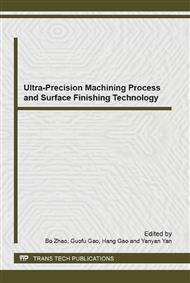p.88
p.93
p.97
p.101
p.107
p.111
p.115
p.119
p.123
Research on ELID Grinding Efficient Surface Forming Mechanism of SiCp/Al Composites
Abstract:
The electrolytic in-process dressing (ELID) grinding technology was adopted for precision grinding experiments of volume fraction of 40% of SiCp/Al composites, obtaining the machined surface roughness of Ra0.030μm. Studying the forming mechanism of processed surface, analyzing several typical grinding surface defects, summarizing the grinding characteristics and removal mechanism of SiCp/Al composites.
Info:
Periodical:
Pages:
107-110
Citation:
Online since:
October 2014
Authors:
Keywords:
Price:
Сopyright:
© 2014 Trans Tech Publications Ltd. All Rights Reserved
Share:
Citation:


